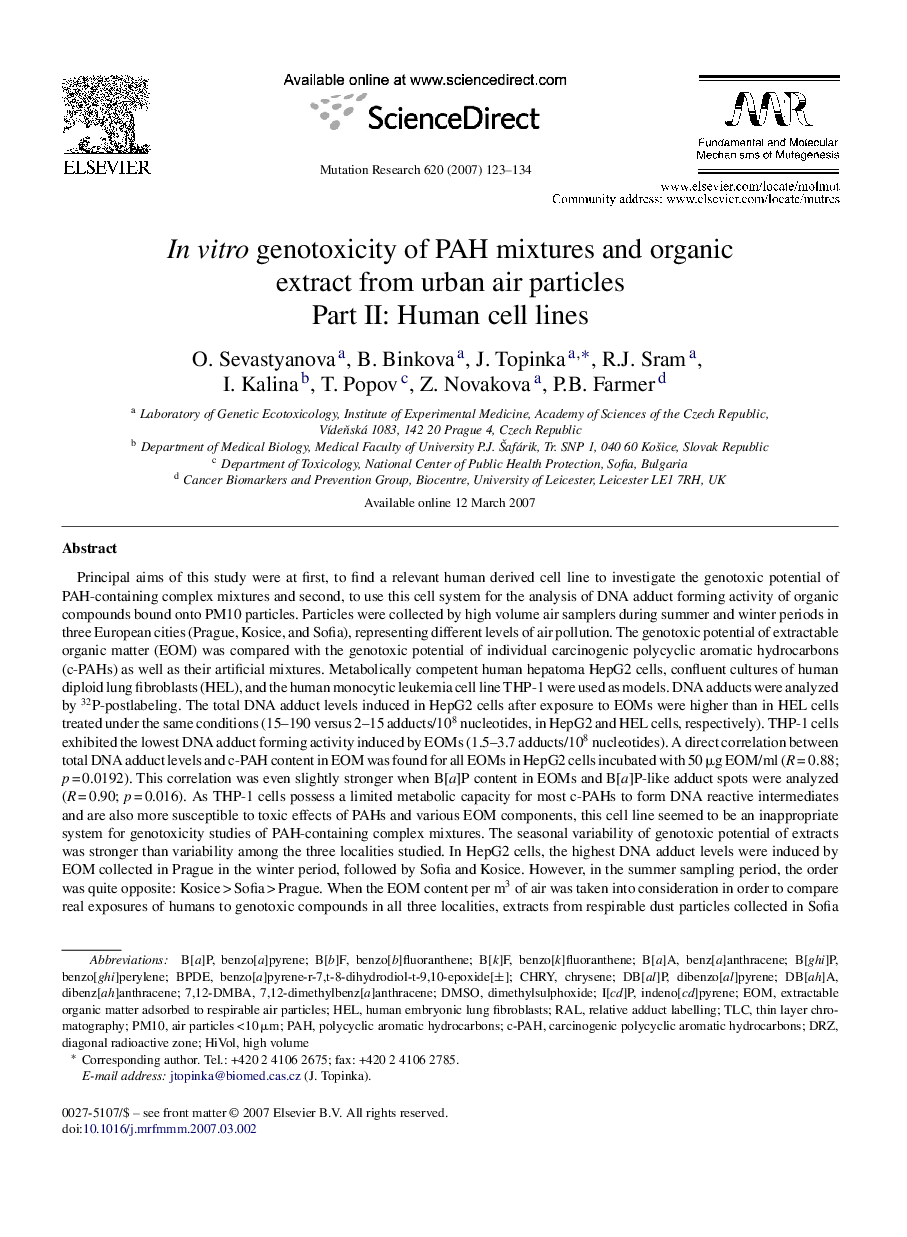| کد مقاله | کد نشریه | سال انتشار | مقاله انگلیسی | نسخه تمام متن |
|---|---|---|---|---|
| 2147368 | 1548409 | 2007 | 12 صفحه PDF | دانلود رایگان |

Principal aims of this study were at first, to find a relevant human derived cell line to investigate the genotoxic potential of PAH-containing complex mixtures and second, to use this cell system for the analysis of DNA adduct forming activity of organic compounds bound onto PM10 particles. Particles were collected by high volume air samplers during summer and winter periods in three European cities (Prague, Kosice, and Sofia), representing different levels of air pollution. The genotoxic potential of extractable organic matter (EOM) was compared with the genotoxic potential of individual carcinogenic polycyclic aromatic hydrocarbons (c-PAHs) as well as their artificial mixtures. Metabolically competent human hepatoma HepG2 cells, confluent cultures of human diploid lung fibroblasts (HEL), and the human monocytic leukemia cell line THP-1 were used as models. DNA adducts were analyzed by 32P-postlabeling. The total DNA adduct levels induced in HepG2 cells after exposure to EOMs were higher than in HEL cells treated under the same conditions (15–190 versus 2–15 adducts/108 nucleotides, in HepG2 and HEL cells, respectively). THP-1 cells exhibited the lowest DNA adduct forming activity induced by EOMs (1.5–3.7 adducts/108 nucleotides). A direct correlation between total DNA adduct levels and c-PAH content in EOM was found for all EOMs in HepG2 cells incubated with 50 μg EOM/ml (R = 0.88; p = 0.0192). This correlation was even slightly stronger when B[a]P content in EOMs and B[a]P-like adduct spots were analyzed (R = 0.90; p = 0.016). As THP-1 cells possess a limited metabolic capacity for most c-PAHs to form DNA reactive intermediates and are also more susceptible to toxic effects of PAHs and various EOM components, this cell line seemed to be an inappropriate system for genotoxicity studies of PAH-containing complex mixtures. The seasonal variability of genotoxic potential of extracts was stronger than variability among the three localities studied. In HepG2 cells, the highest DNA adduct levels were induced by EOM collected in Prague in the winter period, followed by Sofia and Kosice. However, in the summer sampling period, the order was quite opposite: Kosice > Sofia > Prague. When the EOM content per m3 of air was taken into consideration in order to compare real exposures of humans to genotoxic compounds in all three localities, extracts from respirable dust particles collected in Sofia exhibited the highest genotoxicity regardless of the sampling period. The results indicate that most of DNA adducts detected in cells incubated with EOMs have their origin in low concentrations of c-PAHs representing 0.03–0.17% of EOM total mass. Finally, our results suggest that HepG2 cells have a metabolic capacity for PAHs similar to human hepatocytes and represent therefore the best in vitro model for investigating the genotoxic potential of complex mixtures containing PAHs among the three cell lines tested in this study.
Journal: Mutation Research/Fundamental and Molecular Mechanisms of Mutagenesis - Volume 620, Issues 1–2, 1 July 2007, Pages 123–134